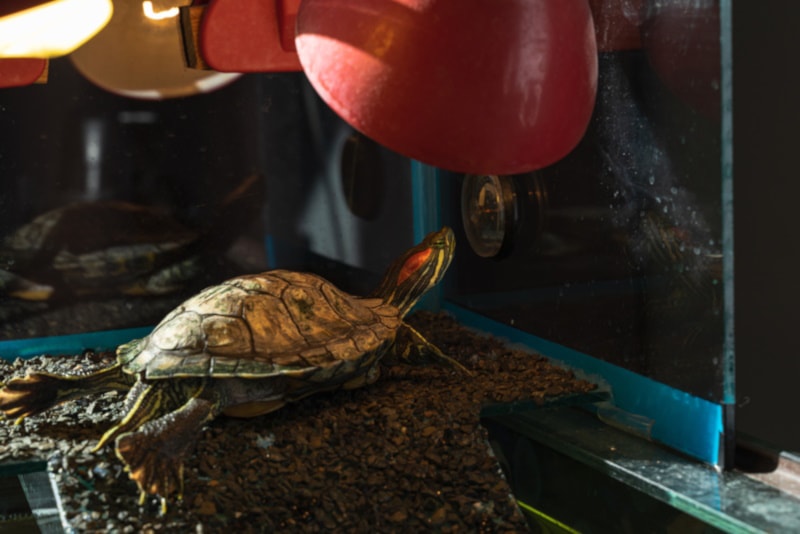- July 21, 2023
Can Turtles Jump? Science-Based Facts & FAQ


You can’t underestimate any animal, not even the humble, slow-moving turtle. Saddled with a cumbersome shell, turtles have a reputation for being some of the most incapable of the animal kingdom’s athletes. But looks can be deceiving, and many people are caught off guard the second they see one of them hop in the air. Turtles can jump several inches in some cases.
While it’s exciting to see, a jumping turtle can also be problematic. Wander too close to a snapping turtle, and it could take a quick leap in your direction to take a nip at you. And in the home, overestimating your tank’s ability to contain your turtle can often result in a missing pet! To keep you and your reptile friends safe, we’ll explain the intriguing details surrounding whether turtles can jump.

Can Turtles Jump?
They don’t gain much hang time, but turtles can jump. Although the heavy shell may make them seem hopelessly ground-bound, it surprisingly only accounts for roughly 25–35% of the turtle’s weight. Turtles can generate enough force to push themselves about 1–4 inches off the ground by bending their legs as much as possible.
A turtle’s jump often pitches its front end high while its rear legs stay closer to the ground. Their legs are short and mostly inflexible. Paired with the awkward shell, they ensure no turtle can make a significant leap.
When Do Turtles Jump?

Fortunately, while they’re jumping skills are meager, turtles don’t have to use them often. In most instances, they’ll only jump for a few reasons, including:
- They feel scared or threatened
- They need to traverse an obstacle
- They need to enter the water
Even that last one is a bit of a stretch. Instead of attempting a controlled leap to get into a pond, turtles typically either lumber at full speed into it or gracelessly fall face-first off an overhanging ledge.
Can All Turtles Jump?
Only small–medium turtles, such as freshwater terrapins, are light enough to boost themselves in the air. Some of the more agile turtle species include Red-Eared Sliders, Box Turtles, Map Turtles, and Mud Turtles. Like tortoises, many semi-aquatic turtles can also dig and climb, often able to scale fences and trees.
The common Snapping Turtle is one of the more sizeable and startling turtles to be able to jump. Weighing 10–35 pounds and known for their finger-removing bite force, these formidable creatures can hop several inches as a defensive strategy. Snapping turtles react faster than you might expect, emphasizing the need to keep a safe distance from the business end.
How High Can Turtles Jump?

No matter the species, turtles have limited jumping ability, and some can’t elevate even the slightest bit. Smaller turtles that jump only achieve 1–2 inches, while snapping turtles and other moderate-sized jumpers can hop 4 inches or more.
A turtle’s jump isn’t straight up. The limited movement in the back legs and their inability to angle their bodies forces turtles to jump in only one direction—forward. They can twist their bodies to a minute amount left or right, with their back legs almost working as a swivel.

How to Stop Turtles from Jumping
Watching turtles jump in nature can be exciting, but it’s not a behavior you want from a turtle in your tank. Turtles may try to escape for several reasons. They’re naturally curious and yearning to explore, but issues like stress or an unsuitable living environment can also boost their motivation to get out.
Ensure Their Environment Is Suitable

Attending to the turtle’s needs is the first step in keeping your turtle from trying to jump out of its enclosure. They need clean water, climate control, and numerous unique features in their habitat, like basking areas and hiding spots. But even with their basic needs met, you often have to take extra steps to protect them from a nasty fall over the side of your tank.
Adjust the Water Level
Since a pet turtle’s “jump” from the tank is more of a “climb-and-fall” maneuver, you don’t have to worry about them vaulting over the edge. Your easiest option may be to lower the water level so they can’t get their feet over the lip of the tank.
Depending on your setup, draining some water could limit your turtle’s comfort or access to items. In these situations, you can maintain the same water level without risking an escape by adding a cover.
Cover the Tank
Open-hole designs like egg crate panels make a perfect lid for a turtle tank. They are easy to cut to size, have wide holes to let in light, and are rigid enough to create a dependable seal. You can also use a screen or other flexible mesh, but they allow turtles to squeeze through. You must either create a rigid frame for the screen to hold it or add a locking system that keeps it tight against the tank.

Final Thoughts
Despite only grabbing a few inches of air, any turtle jumping is an impressive feat. That doesn’t mean you should goad them into it, nor should you expect amazing things from them. Turtles often still need our help in precarious situations, whether they can jump or not. But if you come across a snapping turtle in nature or keep one as a pet, appreciating their surprising agility could be critical in keeping both of you safe.
Featured Image Credit: scuba design, Shutterstock
Tags
What do you think?
Related Articles

New Puppy Checklist: Gear You’ll Need for Your New Dog
Getting a new puppy is really exciting, but before you welcome them home, it’s important to prepare your space for them. Since puppies need a

How Big Do Mini Poodles Get? Vet Reviewed Average Weight & Growth Chart – Dogster
The information is current and up-to-date in accordance with the latest veterinarian research. Learn more » When you buy a Miniature Poodle, you might not

Can Police Dogs Smell Nicotine? Vet Verified Facts & Info – Dogster
The information is current and up-to-date in accordance with the latest veterinarian research. Learn more » While cigarette sales have been declining steadily for decades,

How Old Is 5 in Dog Years? Vet-Approved Guide to Each Size of Dog – Dogster
The information is current and up-to-date in accordance with the latest veterinarian research. Learn more » A common method for calculating a dog’s age is

